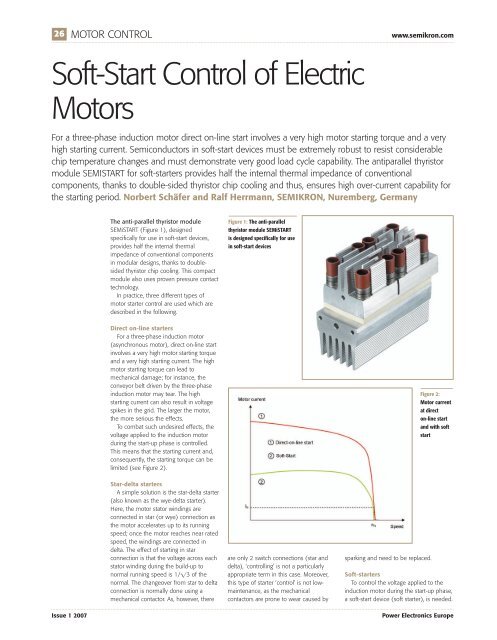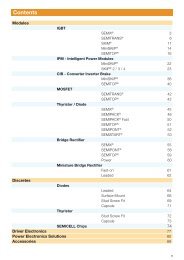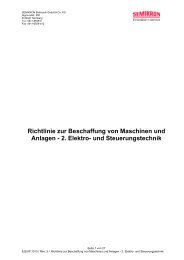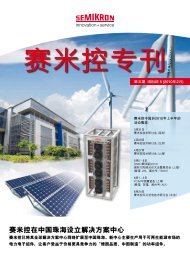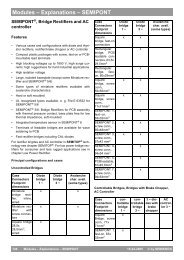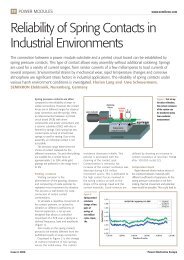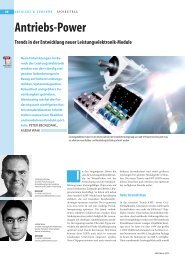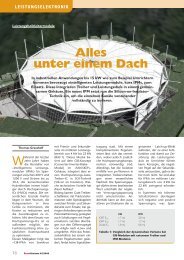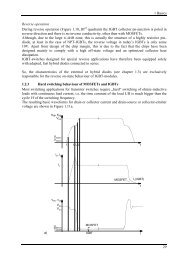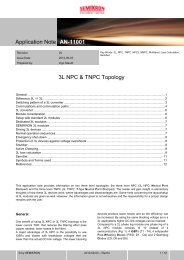motor control - Semikron
motor control - Semikron
motor control - Semikron
You also want an ePaper? Increase the reach of your titles
YUMPU automatically turns print PDFs into web optimized ePapers that Google loves.
26 MOTOR CONTROL www.semikron.com<br />
Soft-Start Control of Electric<br />
Motors<br />
For a three-phase induction <strong>motor</strong> direct on-line start involves a very high <strong>motor</strong> starting torque and a very<br />
high starting current. Semiconductors in soft-start devices must be extremely robust to resist considerable<br />
chip temperature changes and must demonstrate very good load cycle capability. The antiparallel thyristor<br />
module SEMISTART for soft-starters provides half the internal thermal impedance of conventional<br />
components, thanks to double-sided thyristor chip cooling and thus, ensures high over-current capability for<br />
the starting period. Norbert Schäfer and Ralf Herrmann, SEMIKRON, Nuremberg, Germany<br />
The anti-parallel thyristor module<br />
SEMiSTART (Figure 1), designed<br />
specifically for use in soft-start devices,<br />
provides half the internal thermal<br />
impedance of conventional components<br />
in modular designs, thanks to doublesided<br />
thyristor chip cooling. This compact<br />
module also uses proven pressure contact<br />
technology.<br />
In practice, three different types of<br />
<strong>motor</strong> starter <strong>control</strong> are used which are<br />
described in the following.<br />
Figure 1: The anti-parallel<br />
thyristor module SEMiSTART<br />
is designed specifically for use<br />
in soft-start devices<br />
Direct on-line starters<br />
For a three-phase induction <strong>motor</strong><br />
(asynchronous <strong>motor</strong>), direct on-line start<br />
involves a very high <strong>motor</strong> starting torque<br />
and a very high starting current. The high<br />
<strong>motor</strong> starting torque can lead to<br />
mechanical damage; for instance, the<br />
conveyor belt driven by the three-phase<br />
induction <strong>motor</strong> may tear. The high<br />
starting current can also result in voltage<br />
spikes in the grid. The larger the <strong>motor</strong>,<br />
the more serious the effects.<br />
To combat such undesired effects, the<br />
voltage applied to the induction <strong>motor</strong><br />
during the start-up phase is <strong>control</strong>led.<br />
This means that the starting current and,<br />
consequently, the starting torque can be<br />
limited (see Figure 2).<br />
Figure 2:<br />
Motor current<br />
at direct<br />
on-line start<br />
and with soft<br />
start<br />
Star-delta starters<br />
A simple solution is the star-delta starter<br />
(also known as the wye-delta starter).<br />
Here, the <strong>motor</strong> stator windings are<br />
connected in star (or wye) connection as<br />
the <strong>motor</strong> accelerates up to its running<br />
speed; once the <strong>motor</strong> reaches near rated<br />
speed, the windings are connected in<br />
delta. The effect of starting in star<br />
connection is that the voltage across each<br />
stator winding during the build-up to<br />
normal running speed is 1/3 of the<br />
normal. The changeover from star to delta<br />
connection is normally done using a<br />
mechanical contactor. As, however, there<br />
are only 2 switch connections (star and<br />
delta), ‘<strong>control</strong>ling’ is not a particularly<br />
appropriate term in this case. Moreover,<br />
this type of starter ‘<strong>control</strong>’ is not lowmaintenance,<br />
as the mechanical<br />
contactors are prone to wear caused by<br />
sparking and need to be replaced.<br />
Soft-starters<br />
To <strong>control</strong> the voltage applied to the<br />
induction <strong>motor</strong> during the start-up phase,<br />
a soft-start device (soft starter), is needed.<br />
Issue 1 2007<br />
Power Electronics Europe


